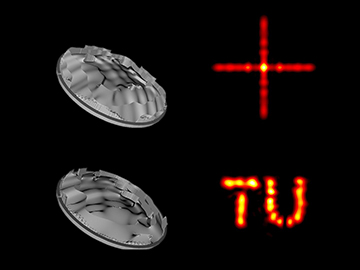![]()
First author and TU Wien Ph.D. candidate Jan Gospodarič (left) and Andrei Pimenov in the lab. [Image: TU Wien]
Taking advantage of spectroscopy and imaging in the terahertz radiation band (roughly 100 GHz to 30 THz) requires, in addition to sources and detectors, the right components to manipulate and shape the beam. Researchers at the Vienna University of Technology (TU Wien) and the University of Vienna, Austria, have now shown how to cost-effectively produce versatile wave plates for THz beam shaping—with a commercially available 3-D printer (Appl. Phys. Lett., doi: 10.1063/1.5027179).
The ability to crank out affordable, made-to-order THz components could, the researchers believe, “facilitate THz imaging on all levels where customized and cost-efficient beam shaping solutions are required.”
Printing phase holograms
The Vienna team, led by Andrei Pimenov of TU Wien’s Institute of Solid State Physics, wanted to get at a method to make so-called phase holograms. These are components that are carefully calculated and shaped to manipulate an incident light wave’s phase in spatially varying ways. Such phase holograms have found numerous applications in thin lenses, diffraction gratings and other components for visible light, but have required specialized metasurface or other fabrication techniques for their development (see “Controlling Light with Geometric-Phase Holograms,” OPN, February 2016).
Pimenov’s team reasoned that, for THz applications, a 3-D printer might work just fine as a platform for creating phase holograms, since ordinary plastic is transparent for THz radiation, and since that radiation has wavelengths on the scale of millimeters. “You don't even need a 3-D printer with an especially high resolution,” Pimenov noted in a press release. “If the precision of the structure is significantly better than the wavelength of the radiation used, then it’s enough. This is no problem for terahertz radiation with a 2-mm wavelength.”
Computer to printer

The calculated and 3-D-printed phase plates (left) were able to reshape an incident Gaussian THz beam into specific modeled patterns (right). [Image: TU Wien]
The researchers began their work at the computer. They used a well-known iterative routine (the Gerchberg-Saxton algorithm) to calculate the phase deformations required to convert an incoming Gaussian 140-THz, 2.14-mm beam into two target profiles—a simple cross, and the TU Wien university logo. They then used those calculations to model the thickness variations in a plastic (polylactide) element that would be needed to produce those phase deformations. Finally, they mapped that model into instructions that they fed into a commercially available 3-D printer with a spatial resolution of 0.1 mm, and used the printer to fashion wave plates with the right characteristics.
The team then put each wave plate in the path of a 140-GHz beam produced with a 30-mW IMPATT (impact ionization avalanche transit-time) semiconductor diode, and used a pyroelectric detector at the back end to measure the intensity profile of the THz radiation that passed through the wave plate. The researchers found that the 3-D printed wave plates, or phase holograms, did indeed modulate the Gaussian incident THz beam into the expected shape.
Pimenov stresses that the method is “relatively easy to apply,” and could as a result “be rapidly introduced for use in many areas” in the emerging universe of THz imaging applications.
